GCSE Astronomy - Topic 2
0.0(0)
0.0(0)
Card Sorting
1/78
There's no tags or description
Looks like no tags are added yet.
Study Analytics
Name | Mastery | Learn | Test | Matching | Spaced |
|---|
No study sessions yet.
79 Terms
1
New cards
State the main constituents of the Solar System.
* 8 planets,
* moons,
* dwarf planets,
* asteroids,
* comets,
* centaurs,
* Trans-Neptunian Objects.
* moons,
* dwarf planets,
* asteroids,
* comets,
* centaurs,
* Trans-Neptunian Objects.
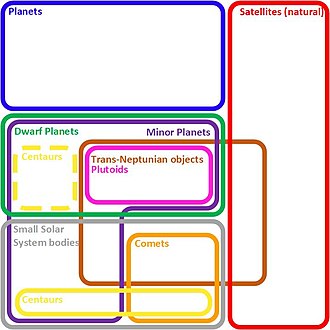
2
New cards
Name three dwarf planets in the Solar System.
1. Ceres,
2. Pluto
3. Eris.
\
==(Also: Haumea, Sedna, Makemake.)==
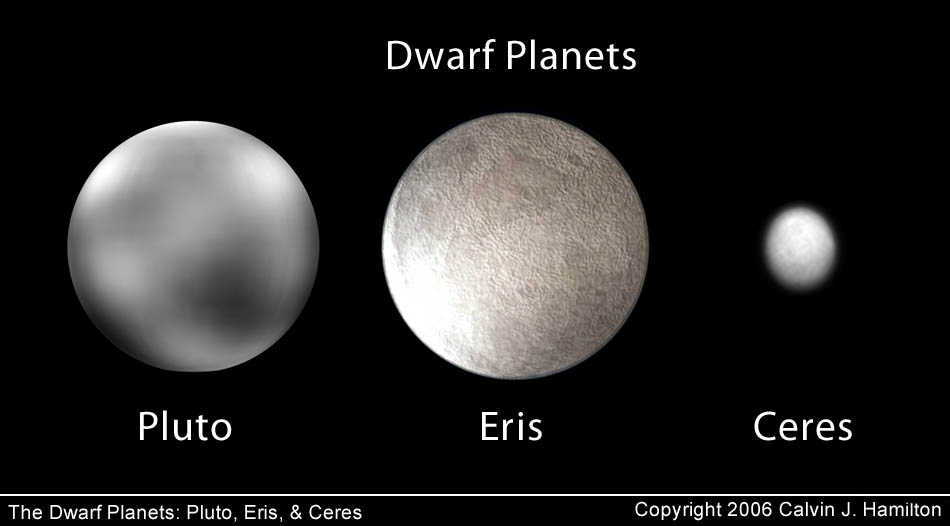
3
New cards
What is a comet?
Nuclei of ice, dust and rock that develop a gaseous coma and tails when close to the Sun.
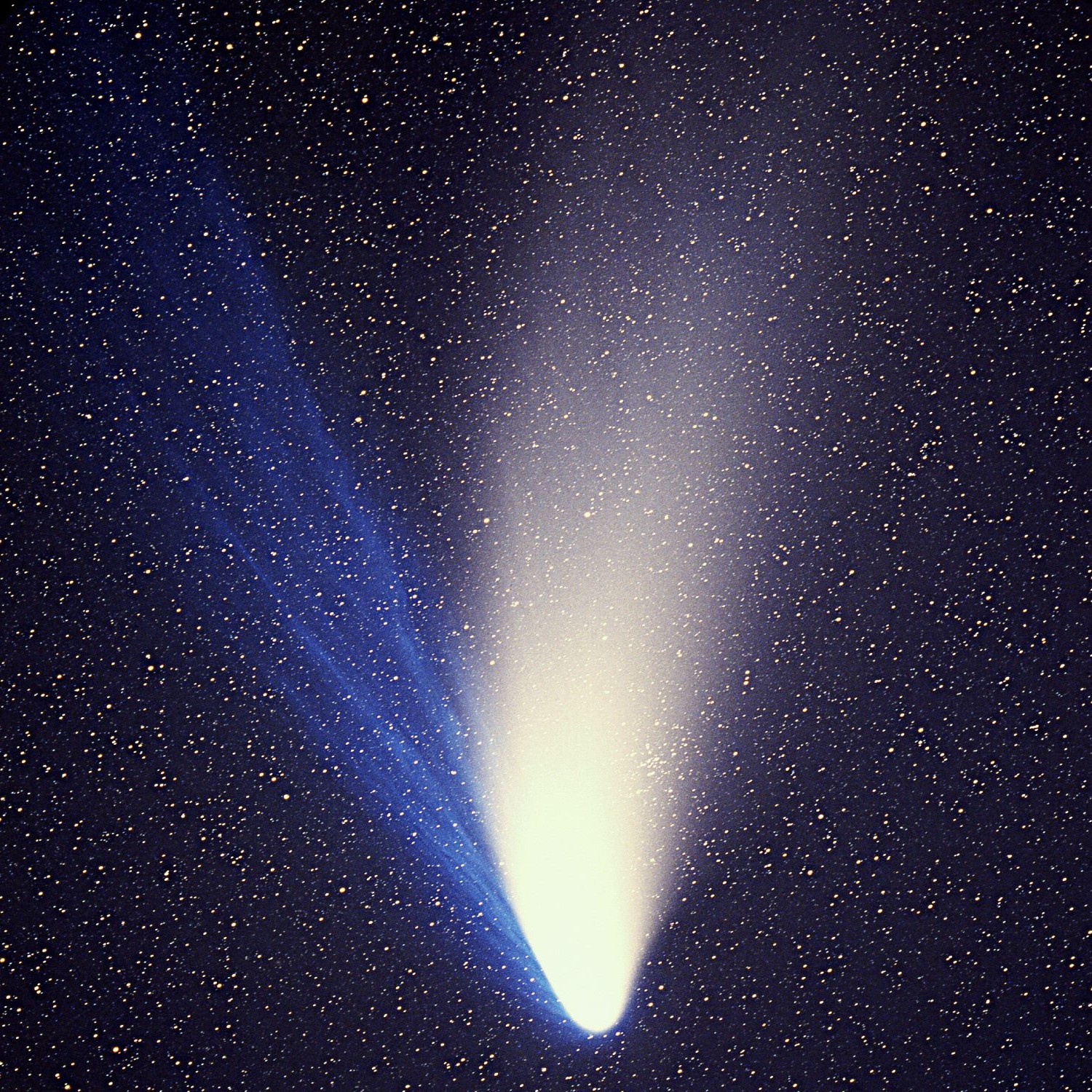
4
New cards
What is a Trans-Neptunian object?
Objects orbiting the Sun beyond Neptune.
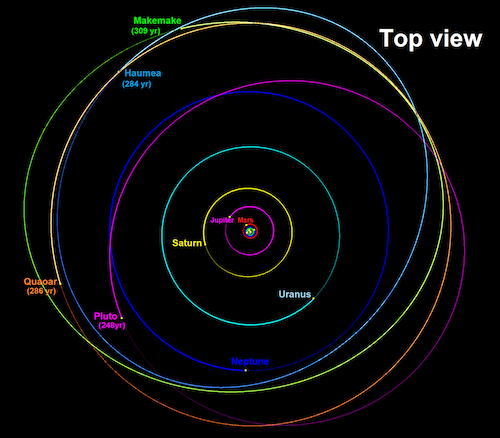
5
New cards
What is a centaur?
* Show **similarities to both comets and asteroids**
* generally ==orbit the Sun between the orbits of Jupiter and Neptune==
* e.g. Chiron, Hidalgo and Asbolus.
* generally ==orbit the Sun between the orbits of Jupiter and Neptune==
* e.g. Chiron, Hidalgo and Asbolus.
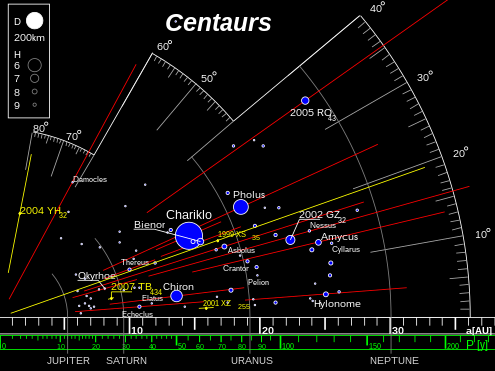
6
New cards
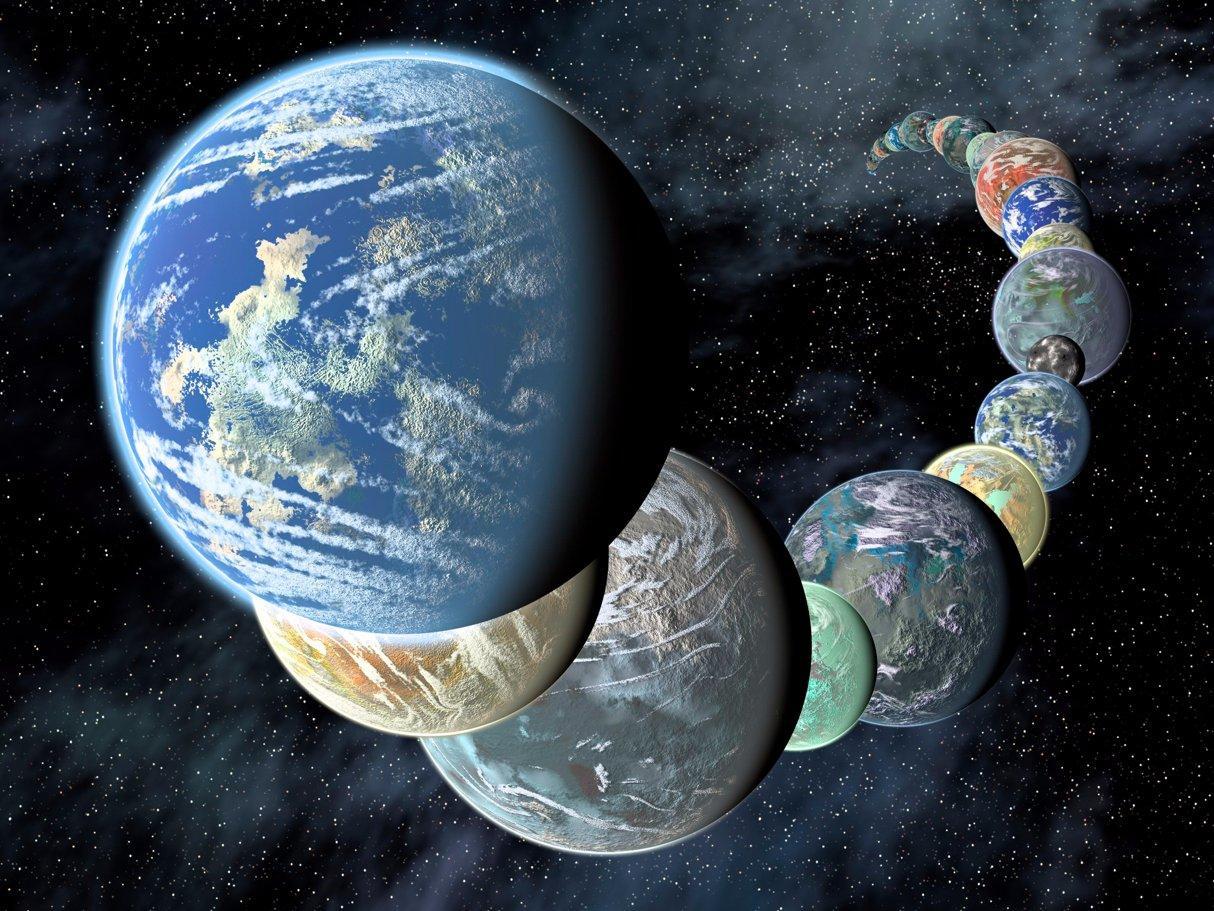
State the features that qualify an object as a ‘planet’.
* An object that is in orbit around the Sun
* large enough to be spherical
* **and** has ‘cleared its orbit’ of other objects.
* large enough to be spherical
* **and** has ‘cleared its orbit’ of other objects.
7
New cards

What is an asteroid?
* **A minor planet**.
* Small soild bodies, with
* the majority orbiting in the Main or **Asteroid Belt** between the orbits of Mars and Jupiter,
* including Vesta (the brightest) and Pallas.
* Small soild bodies, with
* the majority orbiting in the Main or **Asteroid Belt** between the orbits of Mars and Jupiter,
* including Vesta (the brightest) and Pallas.
8
New cards
Name the planets in order of increasing distance from the Sun.
1. Mercury,
2. Venus,
3. Earth,
4. Mars,
5. Jupiter,
6. Saturn,
7. Uranus,
8. Neptune.
9
New cards
What is the ecliptic?
* **The projection of the Earth’s orbit onto the celestial sphere**;
* it may also be defined as the apparent yearly path of the Sun against the stars.
* It is inclined to the celestial equator by 23.5°
* it may also be defined as the apparent yearly path of the Sun against the stars.
* It is inclined to the celestial equator by 23.5°
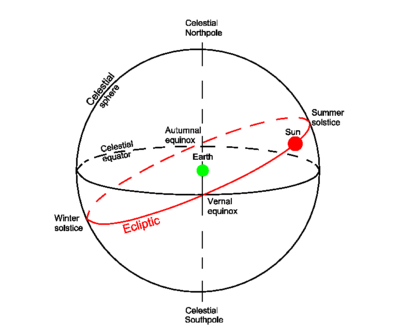
10
New cards
What is an astronomical unit?
1 AU is defined as **150 million km**
==(the mean distance between the Earth and the Sun).==
==(the mean distance between the Earth and the Sun).==

11
New cards
What is the Zodiac?
* A belt stretching right round the sky, **8° to either side of the ecliptic**
* in which the Sun, Moon, and planets (apart from Pluto) are always to be found.
* in which the Sun, Moon, and planets (apart from Pluto) are always to be found.
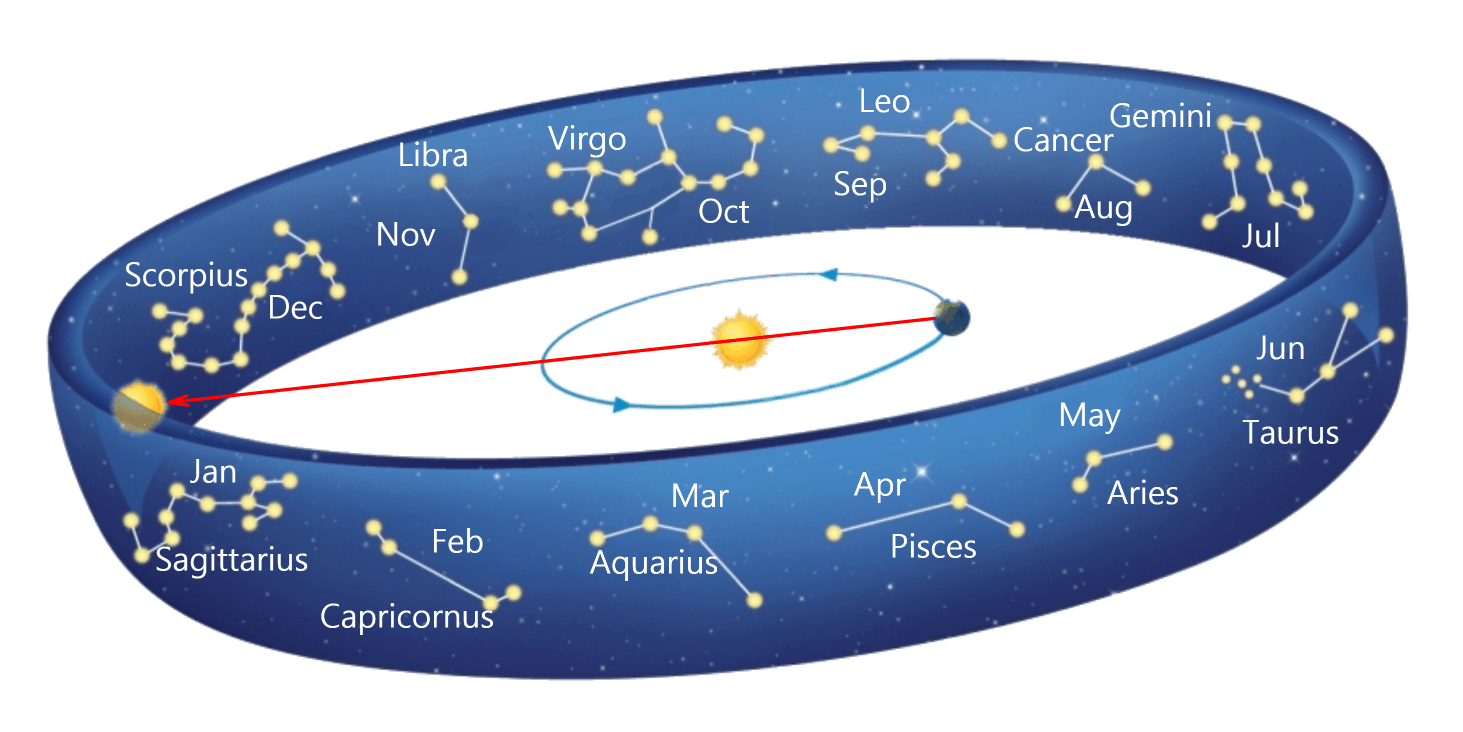
12
New cards
Define the terms: perihelion, aphelion.
**Perihelion** = the position of a body in the Solar System when at its ==closest== to the Sun.
**Aphelion** = the position of a planet or other body when at its greatest distance from the Sun
**Aphelion** = the position of a planet or other body when at its greatest distance from the Sun
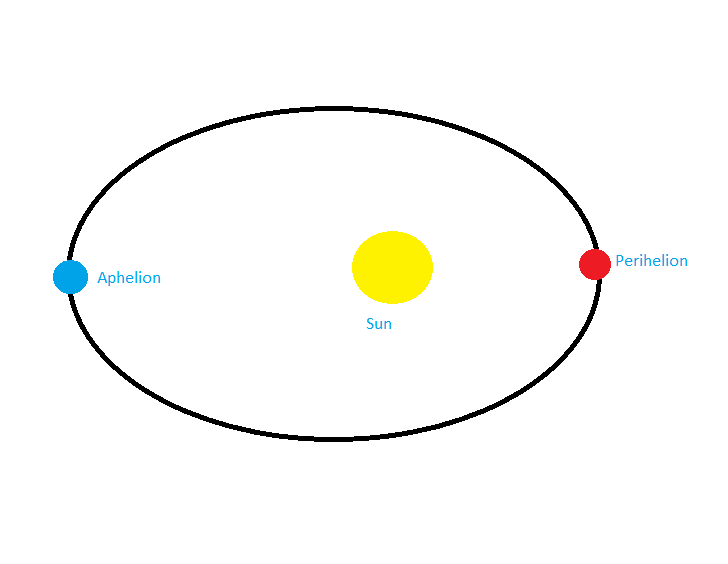
13
New cards
Define the terms: greatest eastern elongation (GEE), greatest western elongation (GWE).
Mercury and Venus are best placed for observation when they are furthest from the Sun in the sky.
The positions in their orbits are known as GEE and GWE and ==**at these positions the angle between the lines planet-Earth and planet-Sun are 90**°==.
The positions in their orbits are known as GEE and GWE and ==**at these positions the angle between the lines planet-Earth and planet-Sun are 90**°==.
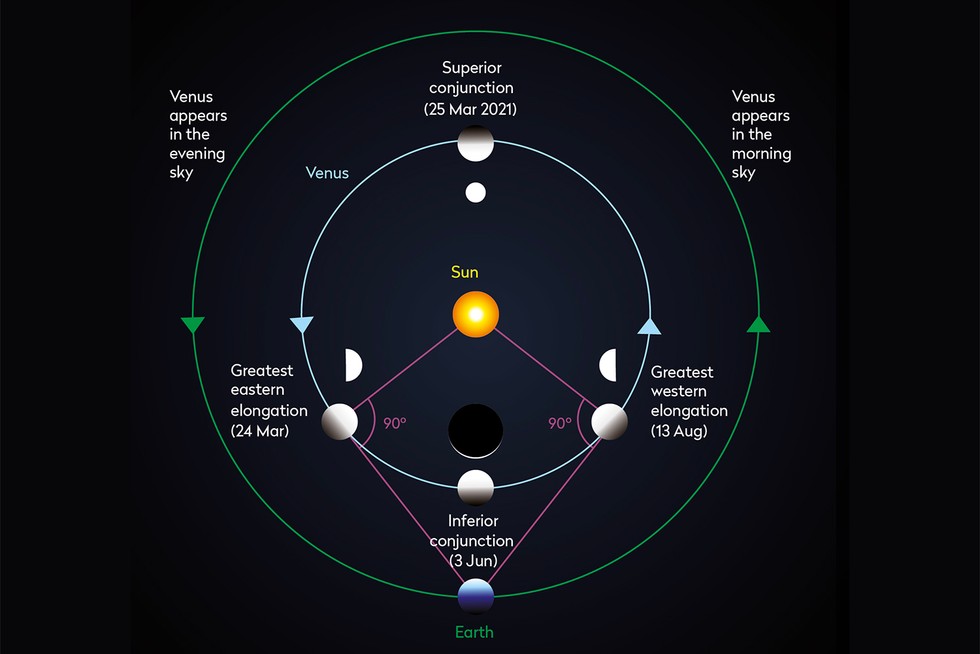
14
New cards
What is meant by the term retrograde motion?
**Orbital or rotational movement in the sense opposite to that of the Earth’s movement or rotation**.
A planet is said to move in an apparent retrograde direction when shifting from east to west on the celestial sphere.
A planet is said to move in an apparent retrograde direction when shifting from east to west on the celestial sphere.
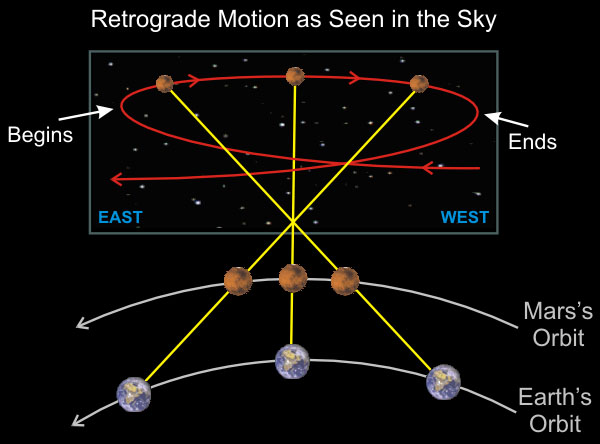
15
New cards
Describe the orbit of the planets around the Sun.
* The planets orbit the Sun in **ellipses**.
* The plane of the Earth’s orbit is called the ecliptic and the planes of all the planets are inclined by only a few degrees to this.
* The plane of the Earth’s orbit is called the ecliptic and the planes of all the planets are inclined by only a few degrees to this.
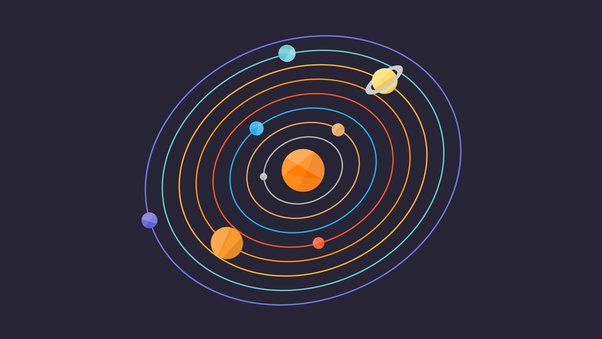
16
New cards
Define the term: conjunction.
a) A planet is in conjunction with a star or another planet when it passes by it in the sky;
* A planet is in **superior conjunction** when it is on the ==far side of the Sun with respect to the Earth==,
* and in **inferior conjunction** when passing between the Sun and the Earth.
* A planet is in **superior conjunction** when it is on the ==far side of the Sun with respect to the Earth==,
* and in **inferior conjunction** when passing between the Sun and the Earth.
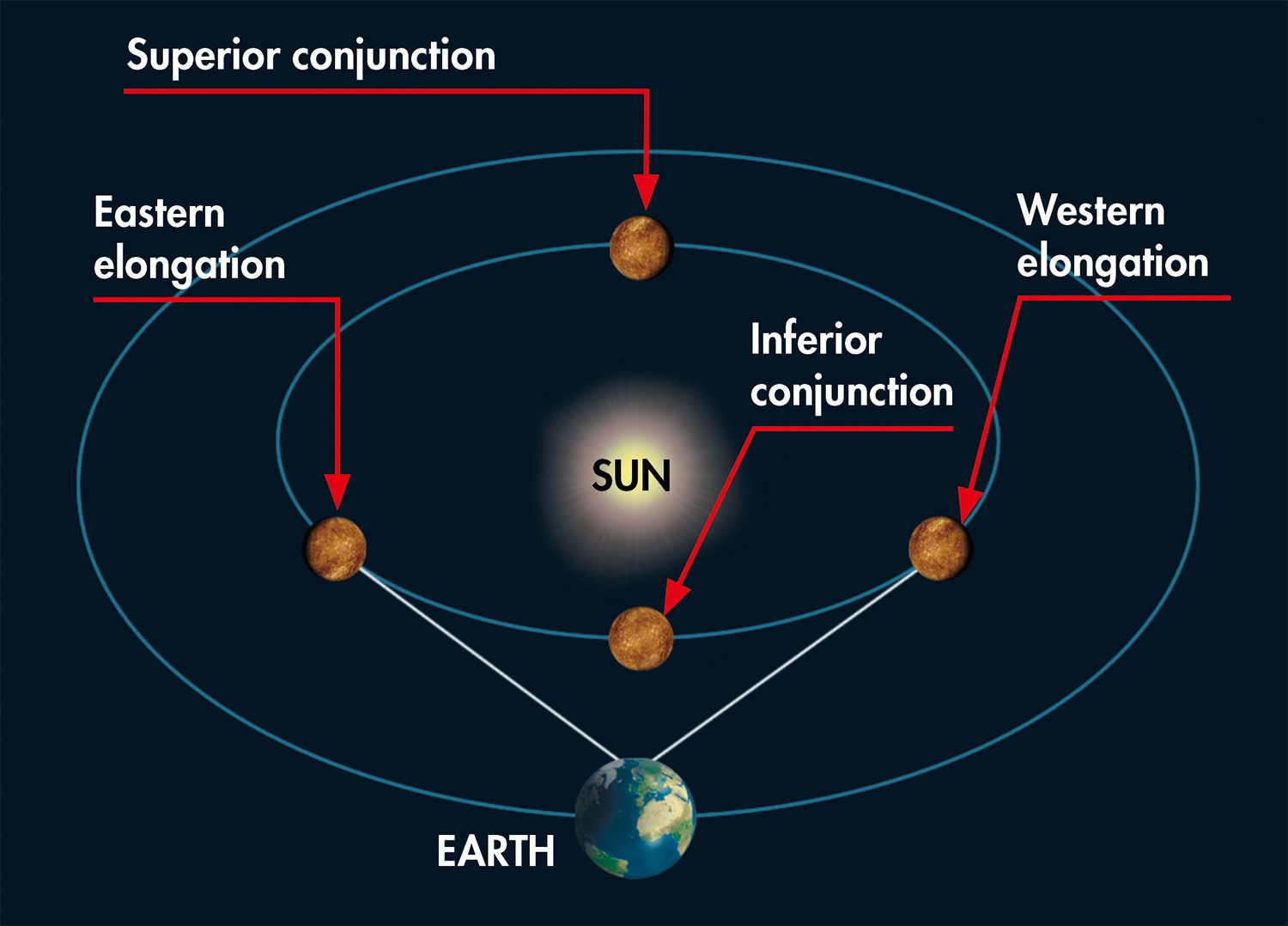
17
New cards
Define the term: transit.
a) The passage of a celestial object across the observer’s meridian
b) The projection of Mercury or Venus against the disc of the Sun.
b) The projection of Mercury or Venus against the disc of the Sun.
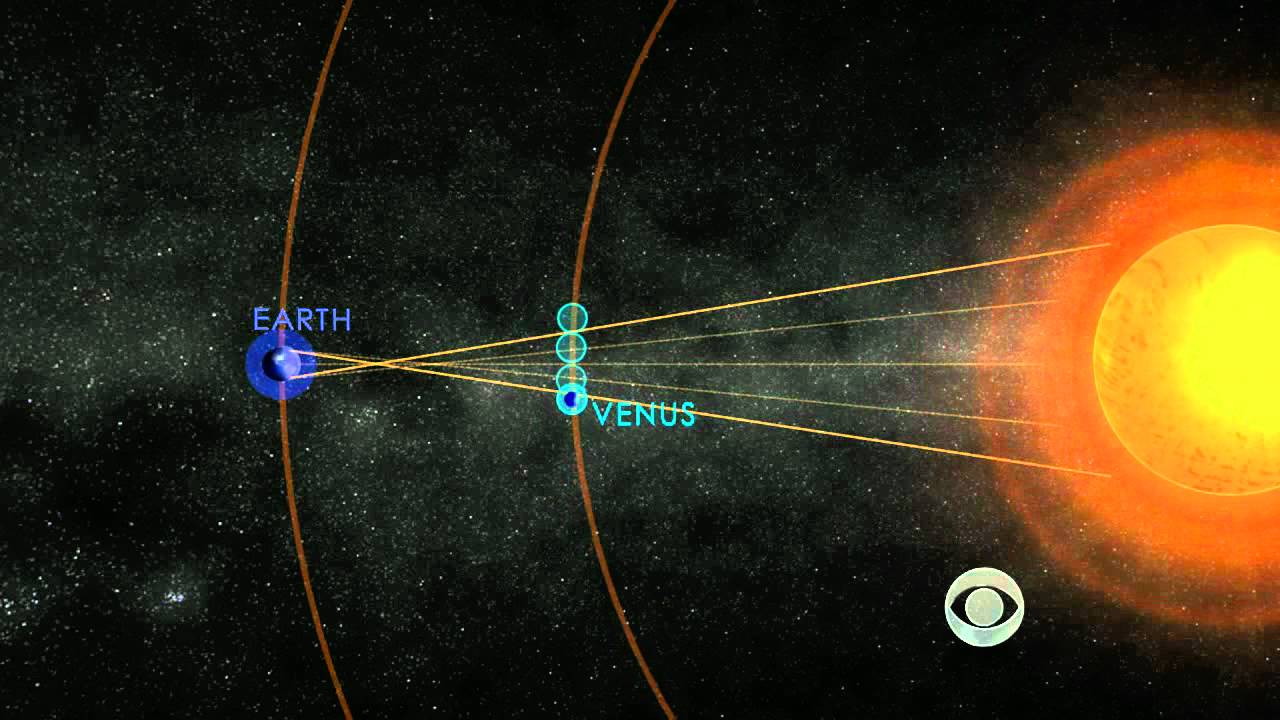
18
New cards
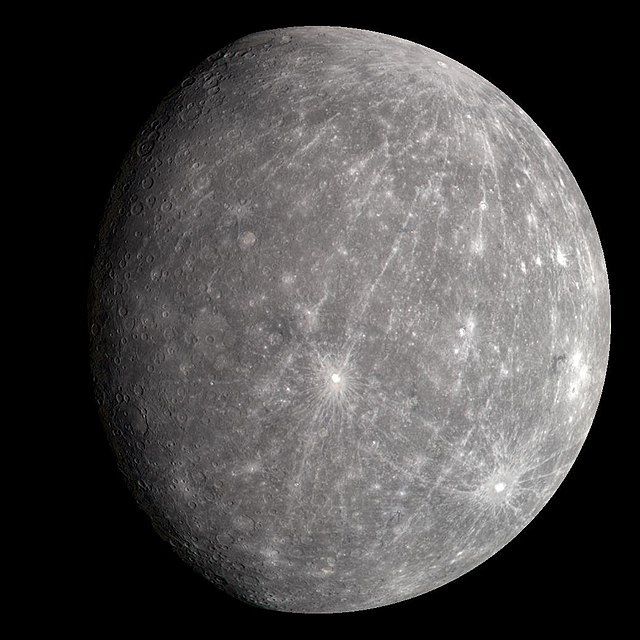
Describe the physical characteristics of Mercury.
* Heavily cratered and contains highlands
* lava-filled basins
* many parts of its surface appear almost identical to the Moon.
* lava-filled basins
* many parts of its surface appear almost identical to the Moon.
19
New cards
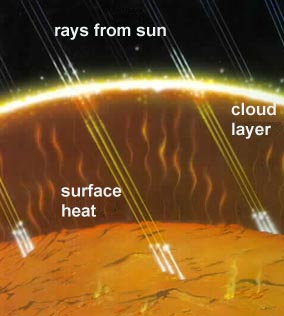
What is the link between Venus and global warming?
Venus has a dense atmosphere containing CO2; this prevents infrared radiation leaving Venus, making the surface and lower atmosphere so hot – a ‘runaway greenhouse effect’.
20
New cards
Define the term: opposition.
The position of **a planet when exactly opposite to the Sun in the sky**.
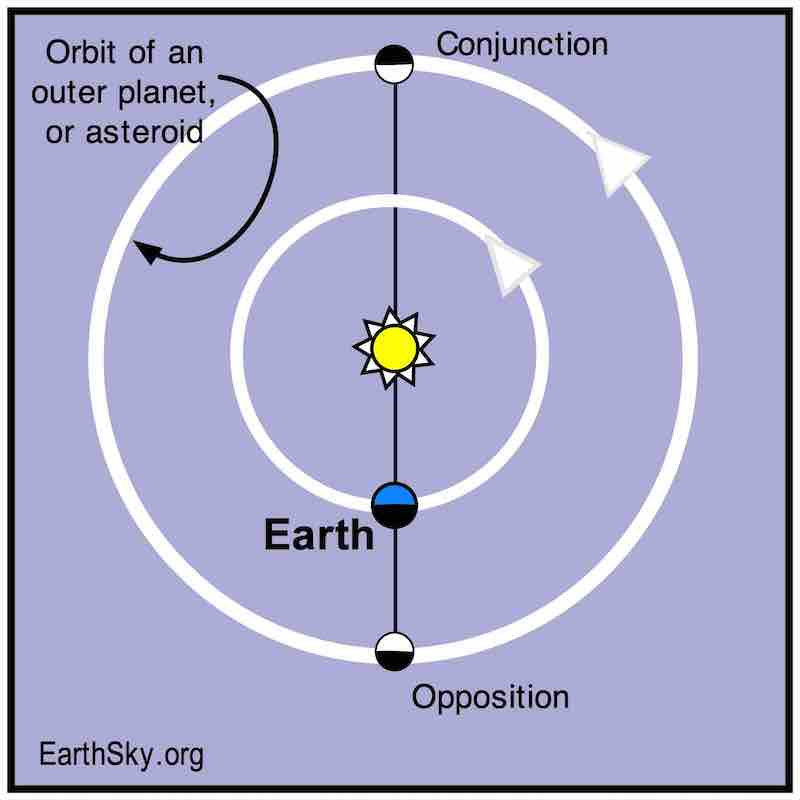
21
New cards
Define the term: occultation.
**The covering-up of one celestial body by another**. Strictly speaking, a solar eclipse is an occultation of the Sun by the Moon.
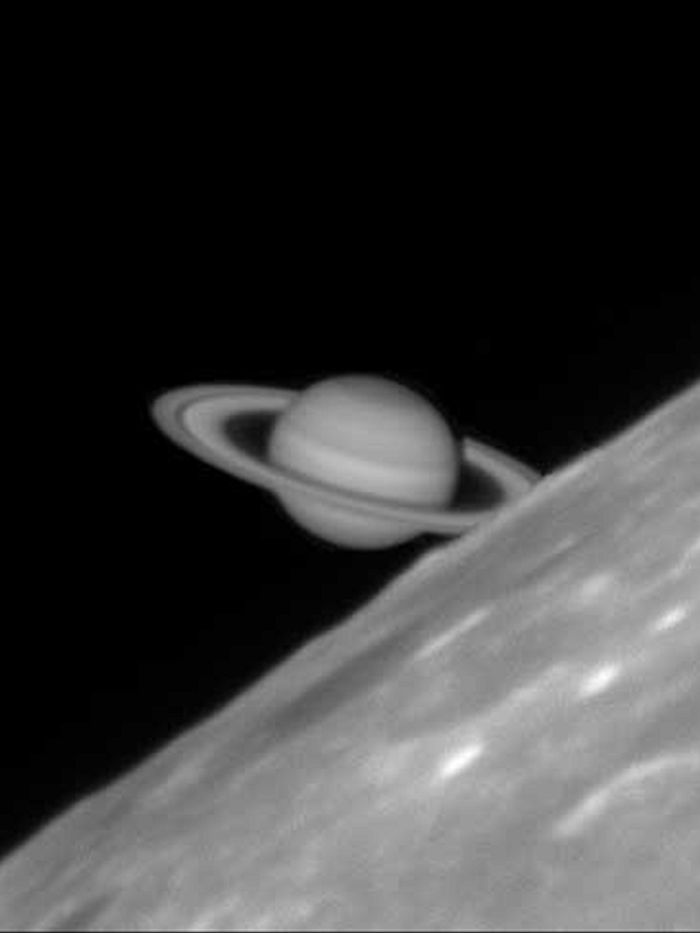
22
New cards
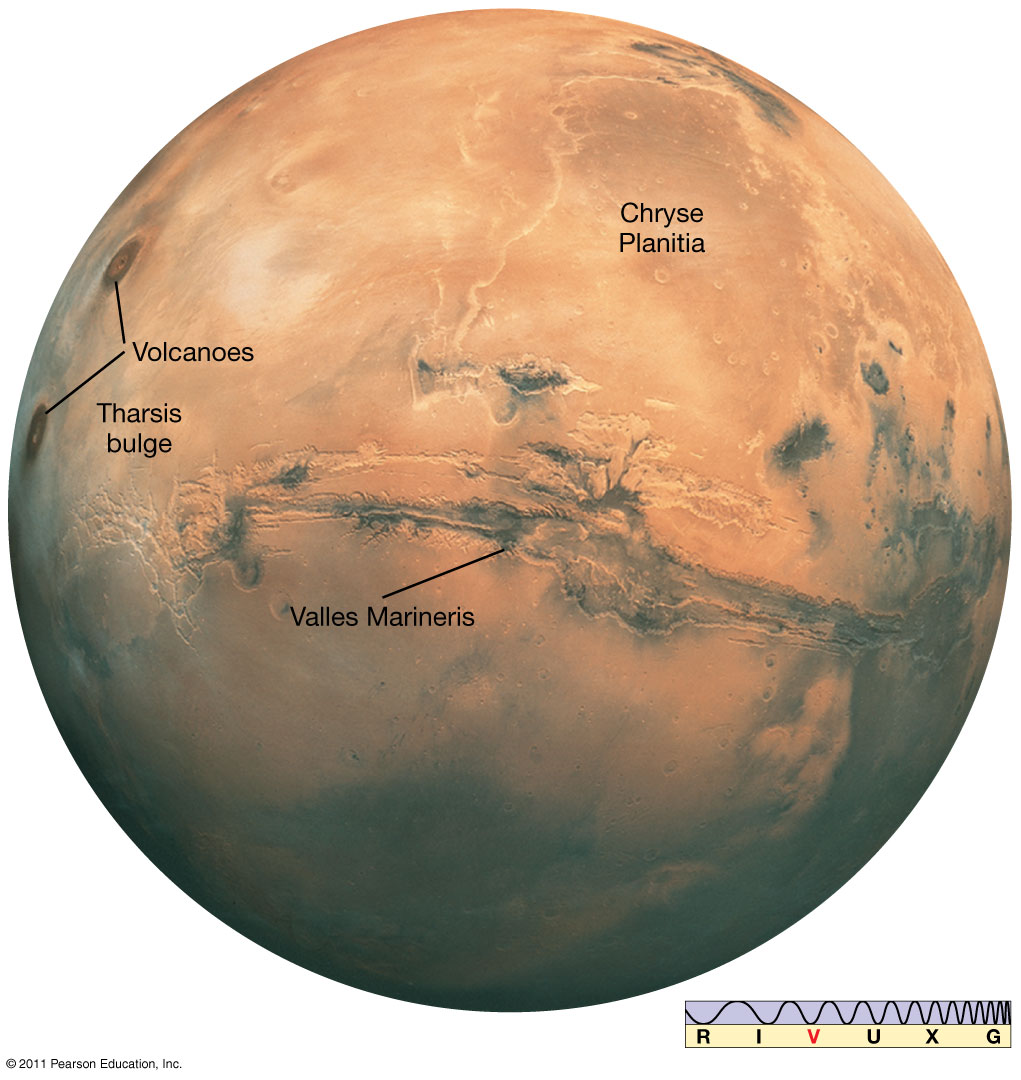
Describe the physical properties of Mars.
* Mars has **iron-rich rocks**, **seasonal ice caps**
* **450 km-long canyon called Valles Marineris**
* the highest volcano in the Solar System – **Olympus Mons**
* violent **dust storms** rage across its surface.
* **450 km-long canyon called Valles Marineris**
* the highest volcano in the Solar System – **Olympus Mons**
* violent **dust storms** rage across its surface.
23
New cards
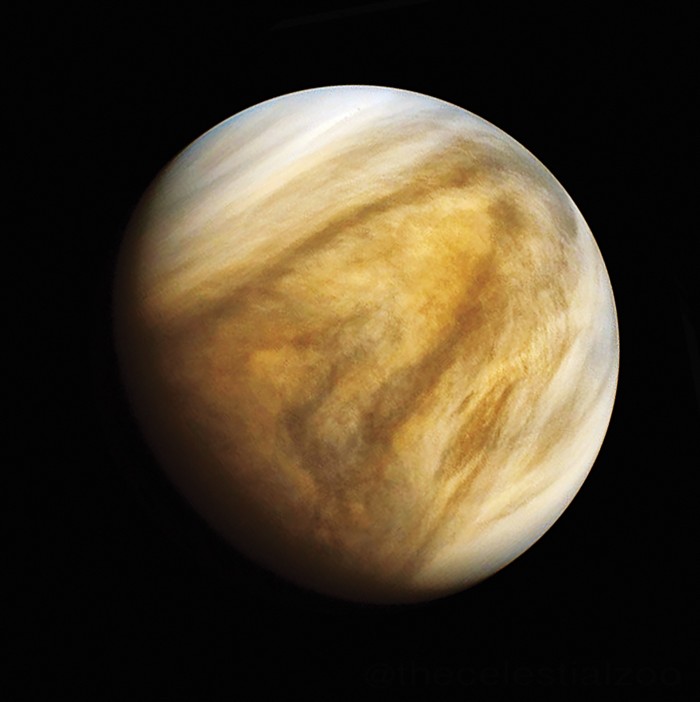
Describe the physical properties of Venus.
* **Backwards-spinning,** **similar size to the Earth**.
* Clouds of sulfuric acid,
* s**urface pressure 90X** greater than the Earth,
* **surface temperature of 470 °C**.
* **Dense atmosphere containing carbon dioxide.**
* Clouds of sulfuric acid,
* s**urface pressure 90X** greater than the Earth,
* **surface temperature of 470 °C**.
* **Dense atmosphere containing carbon dioxide.**
24
New cards
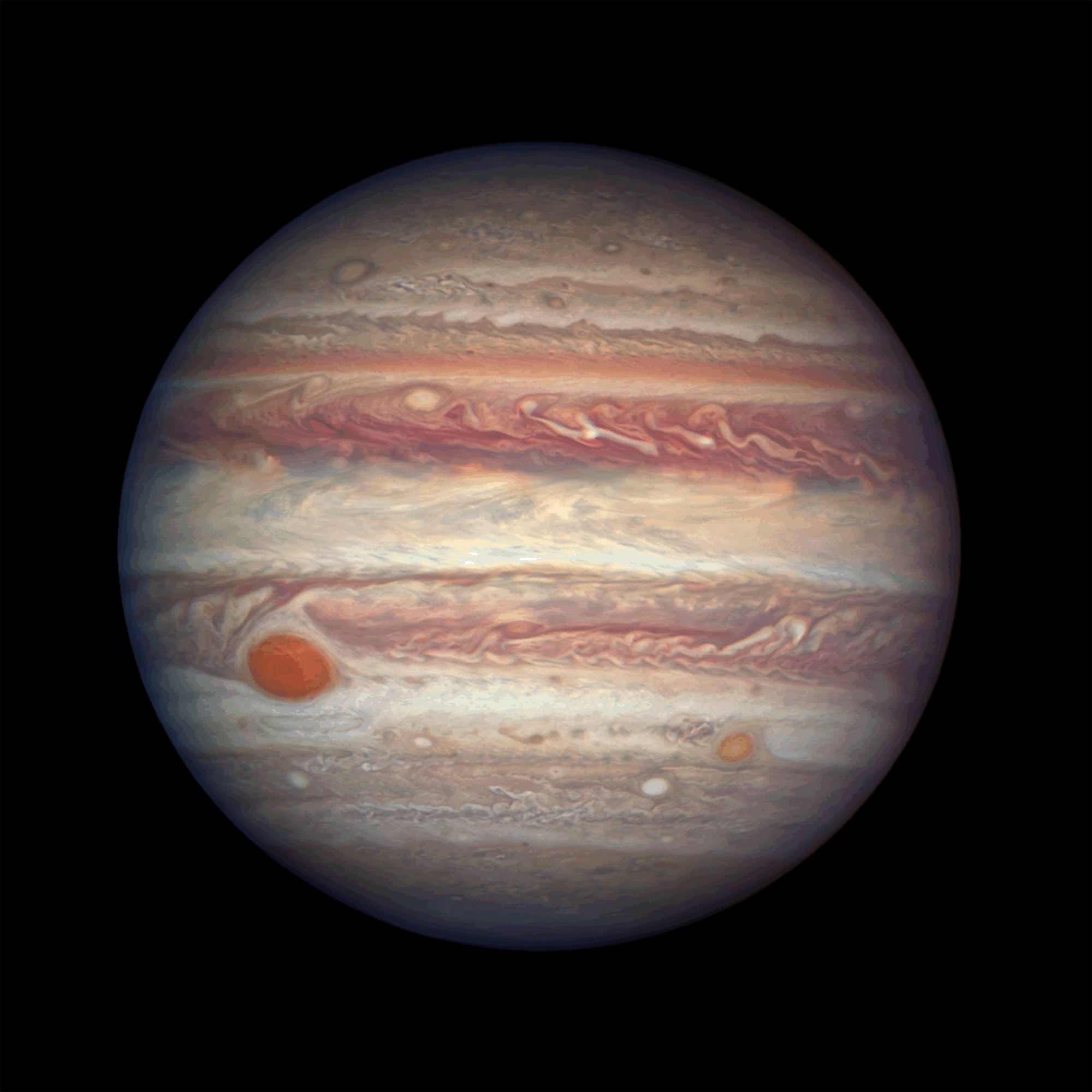
Describe some of the physical characteristics of Jupiter.
* Jupiter **rotates on its axis in only 10 hours**, producing an equatorial bulge
* dynamic wind systems that split the atmosphere into a series of red-brown belts and yellow-white zones.
* The **Great Red Spot (GRS**) is an anticyclone weather system, larger than the planet Earth.
* dynamic wind systems that split the atmosphere into a series of red-brown belts and yellow-white zones.
* The **Great Red Spot (GRS**) is an anticyclone weather system, larger than the planet Earth.
25
New cards
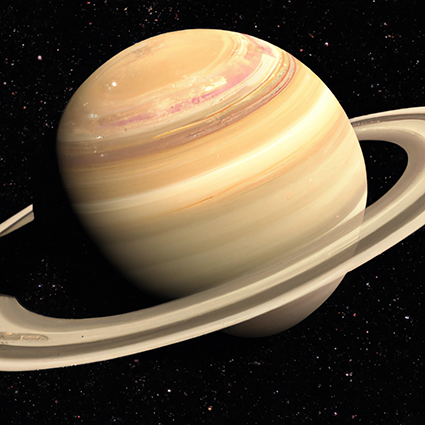
What are some of the physical characteristics of Saturn?
* Saturn is a similar gas giant to Jupiter but it reveals less structure in its atmosphere
* shows **no evidence of long-term features like Jupiter’s GRS**.
* Saturn’s most notable feature is its **majestic rings**.
* shows **no evidence of long-term features like Jupiter’s GRS**.
* Saturn’s most notable feature is its **majestic rings**.
26
New cards
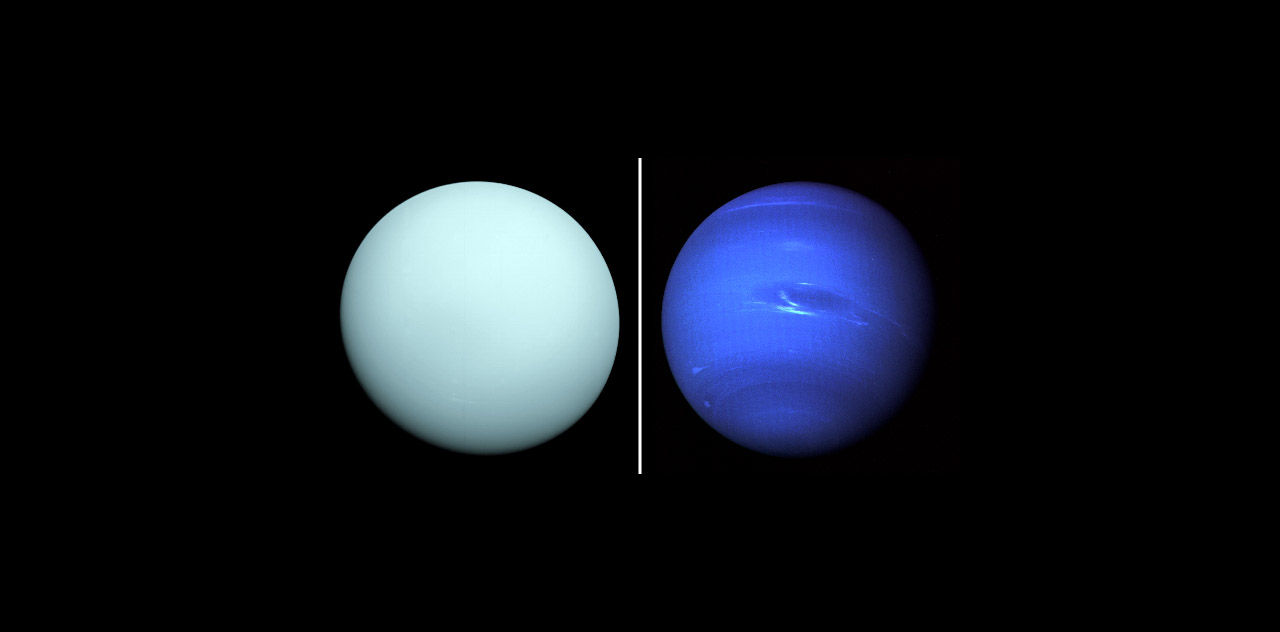
What are the atmospheres of Uranus and Neptune made up of?
Both are gas giants of similar size made up of **hydrogen**, **helium**, **methane** and **ammonia**.
27
New cards
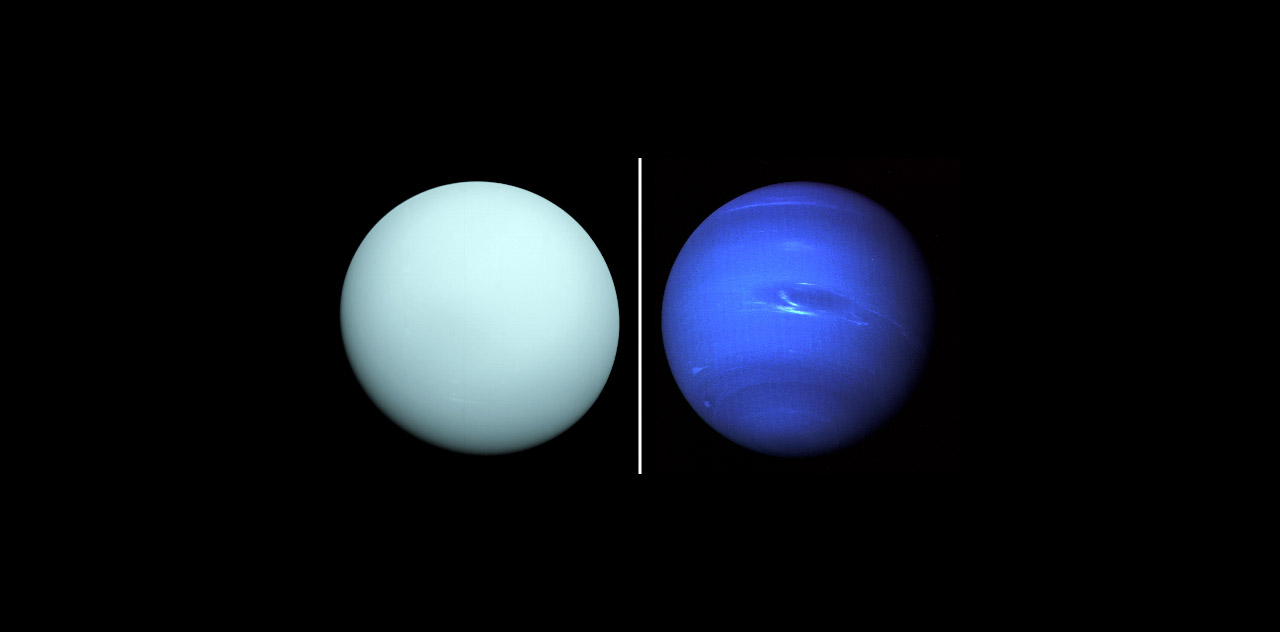
State some differences in the physical characteristics of Uranus and Neptune.
* **Uranus spins almost on its side** and its ==surface is almost featureless==;
* **Neptune shows many surface markings** (including the Great Dark Spot) with dark banded features and cirrus-like clouds of frozen methane at high altitudes.
* **Neptune shows many surface markings** (including the Great Dark Spot) with dark banded features and cirrus-like clouds of frozen methane at high altitudes.
28
New cards
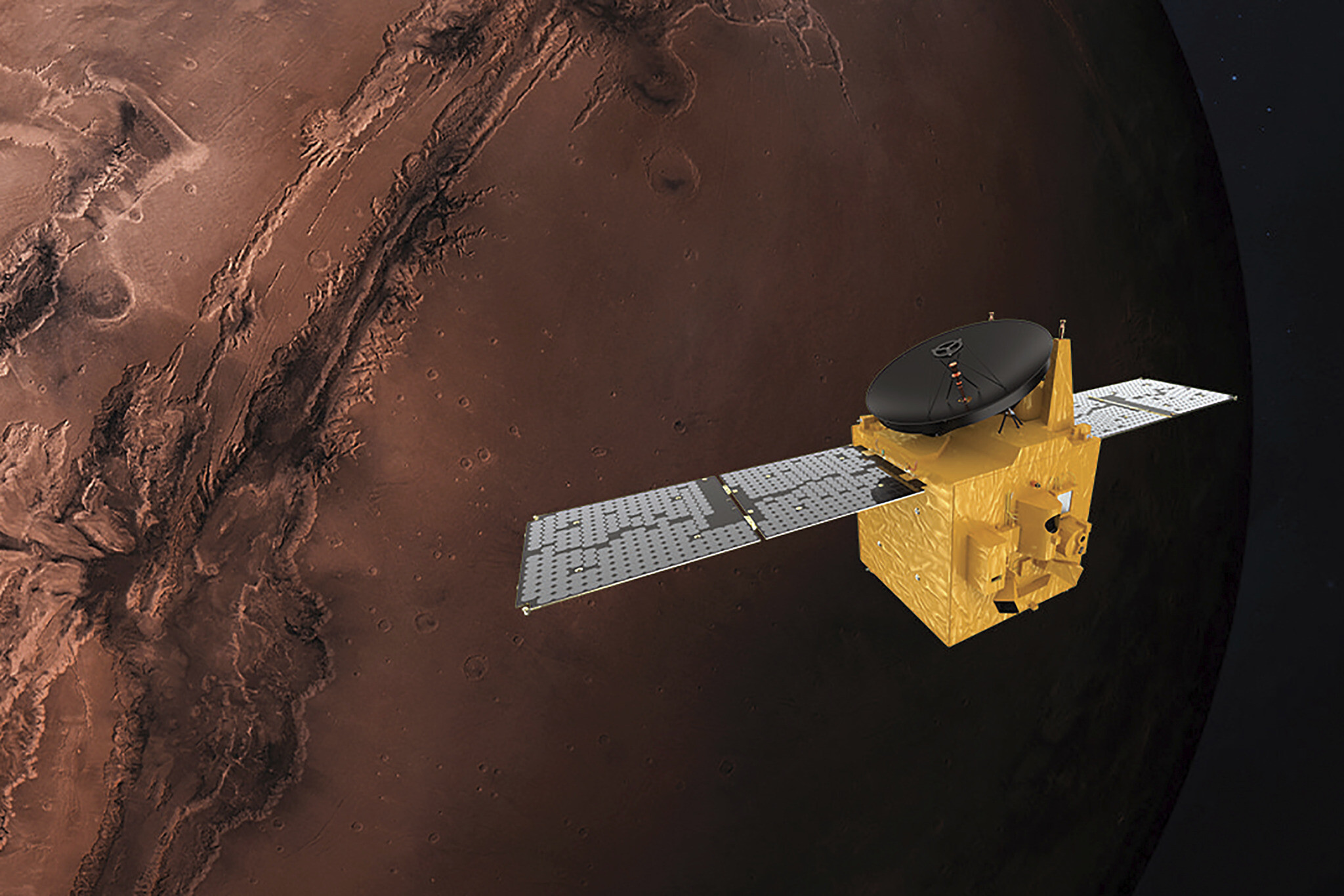
Name five general techniques by unmanned probes to investigate planets and other Solar System bodies.
1. Flyby
2. orbit
3. landing
4. impact collision
5. collecting and returning
29
New cards
State some of the problems associated with manned exploration of the Solar System.
* Space Adaptation Syndrome,
* problems associated with living in a zero-gravity environment (brittle bones, muscle fatigue, reduced red blood cell counts),
* communication delays,
* radiation risk,
* psychological problems.
* problems associated with living in a zero-gravity environment (brittle bones, muscle fatigue, reduced red blood cell counts),
* communication delays,
* radiation risk,
* psychological problems.
30
New cards
What are the names of the two moons of Mars?
1. Phobos (Fear)
2. Deimos (Terror).
31
New cards
What is the believed origins of the moons of Mars?
Captured bodies from the Asteroid Belt.
32
New cards
What are the names of the 4 Galilean moons of Jupiter?
1. Io,
2. Europa
3. Ganymede,
4. Calliso
\
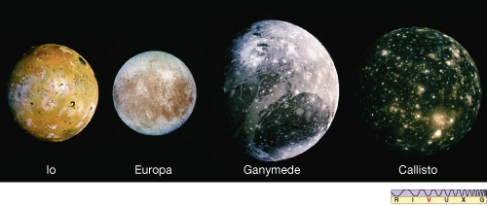
33
New cards
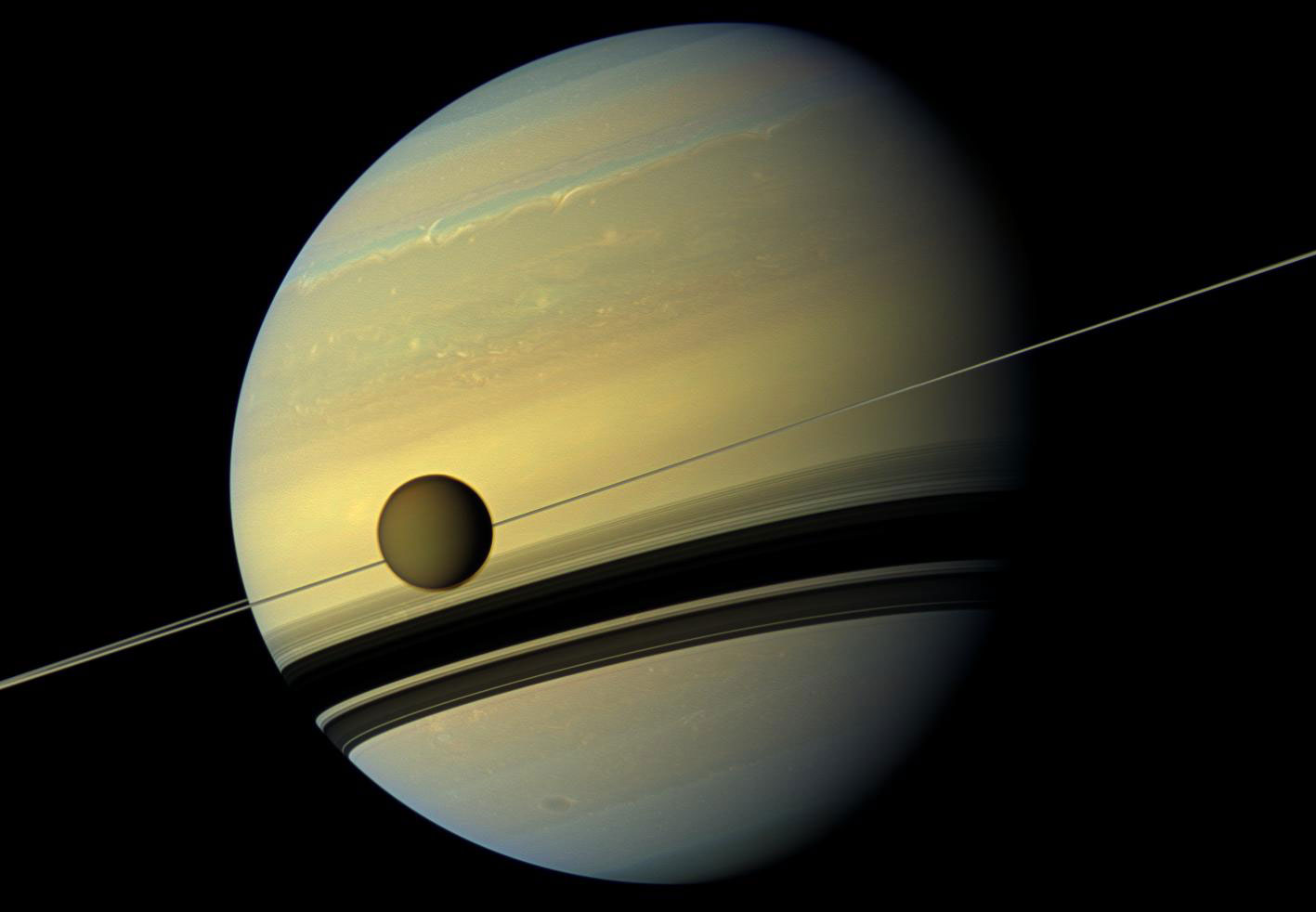
Which is the only moon in the Solar System which has a dense atmosphere?
Saturn’s moon **Titan**, which has an atmosphere that extends 600 km from the moon’s surface, consisting of 95% nitrogen and methane and other hydrocarbons.
34
New cards
What is unusual about the orbit of Triton around Neptune?
* Its **orbit is highly-inclined** and revolves around Neptune
* and in the **opposite sense to that in which Neptune spins** (the only large moon in the Solar System to do so).
* and in the **opposite sense to that in which Neptune spins** (the only large moon in the Solar System to do so).
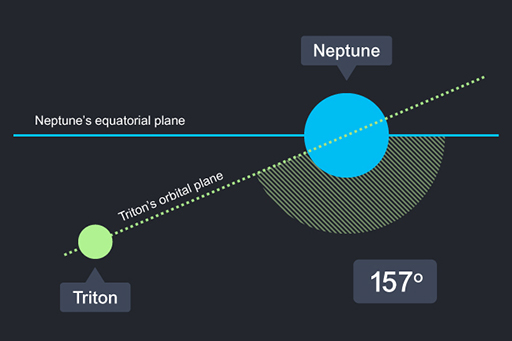
35
New cards
What is the proposed origin of Neptune’s moon Triton?
Probably a captured body, but because of its size and mass.
36
New cards
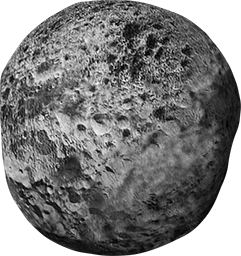
What is the proposed origin of Neptune’s moon Proteus?
As Proteus orbits in the plane of Neptune’s equator and in the same sense as the planet’s spin, it is suggested that Proteus formed at the same time as Neptune. (**Although some astronomers believe that Proteus and Saturn’s equally-dark moon Phoebe were formed in a different part of the Solar System and were subsequently captured by the two planets**.)
37
New cards
What is unusual about the orbit of Neptune’s moon Nereid?
It is the **most highly eccentric orbit of any moon or planet in the Solar System**; it takes 360 days to orbit Neptune. It is most likely a captured Kuiper Belt object.
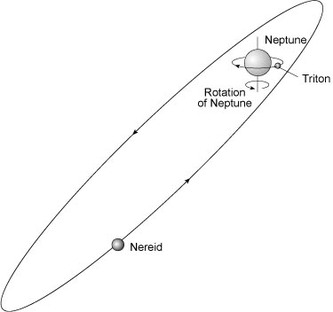
38
New cards
What is the Kuiper belt?
Frozen objects (mainly methane, ammonia and water) that **lie mostly beyond Neptune**. ==Thought to be the source of comets.==
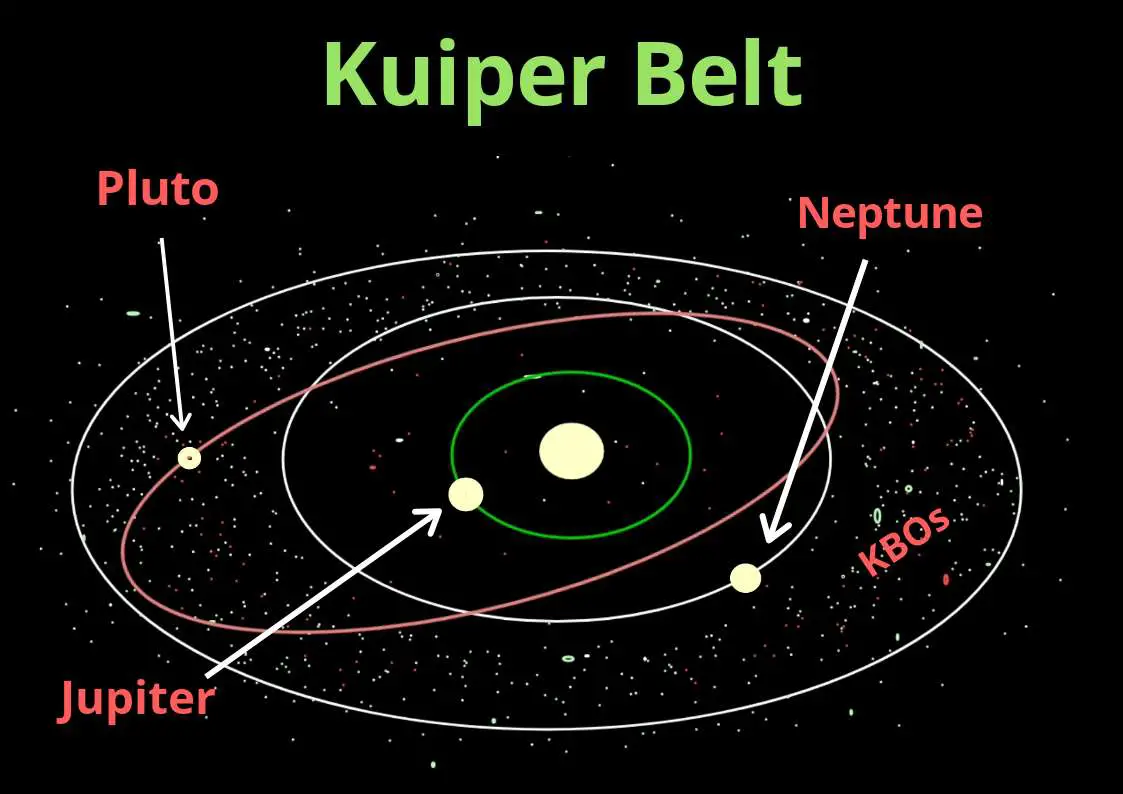
39
New cards
What is the Oort cloud?
The **outermost region of the Solar System** (at a distance of 1.5 light years from the Sun). Consists of billions of small lumps of rock and ice. The objects of the Oort cloud are too faint to be seen using visible light.
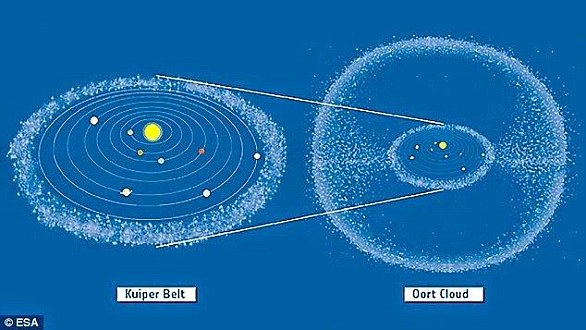
40
New cards
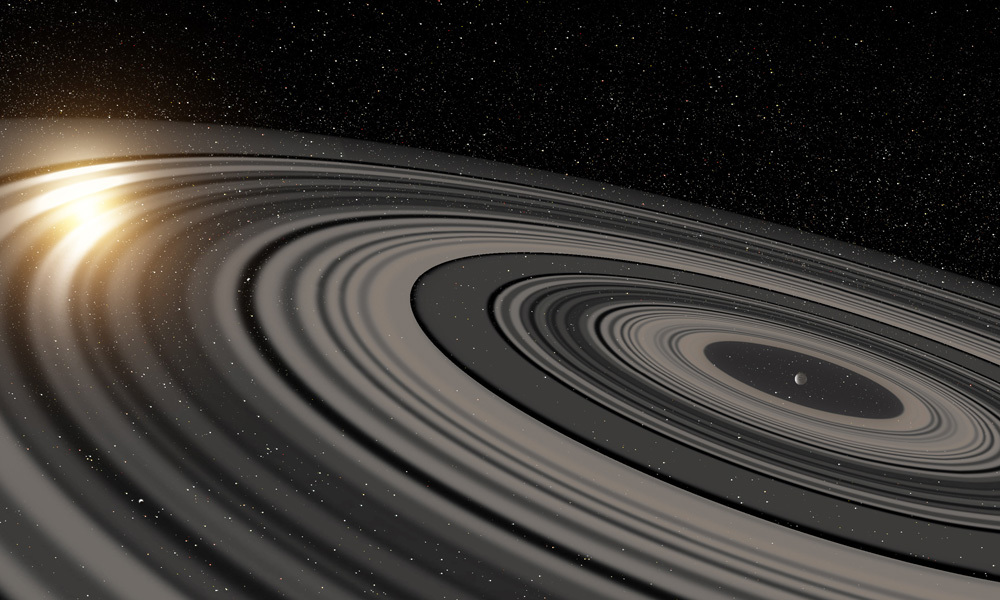
What is a ring system?
Billions of individual particles of ice, rock and dust that range from a few micrometres to several metres in size. The exact composition varies from planet to planet.
41
New cards
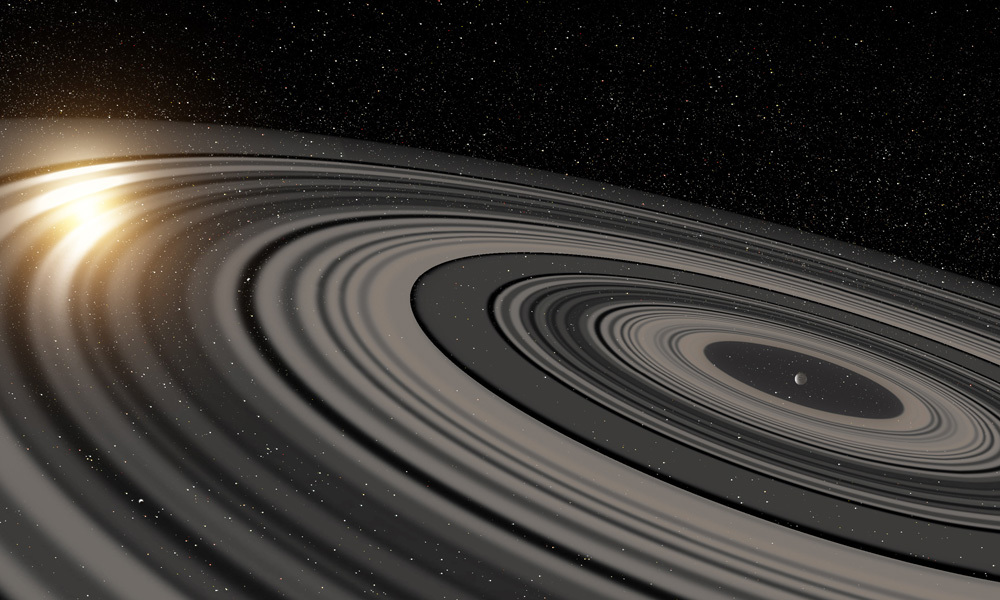
What are possible origins of ring systems?
* Debris left over after the formation of the planet;
* large impacts between moons;
* a moon that was torn apart through tidal gravitational forces;
* material ejected from the surfaces of moons by meteoric impacts.
* large impacts between moons;
* a moon that was torn apart through tidal gravitational forces;
* material ejected from the surfaces of moons by meteoric impacts.
42
New cards
What is a comet?
Balls of **rock and ice** (often called ‘dirty snowballs’ or ‘icy dirtballs’) that form tails in the course of their **highly-elliptical orbits around the Sun**.
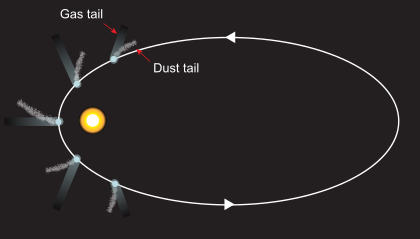
43
New cards
What are the two classes of comet?
* **Short-period** comets (**periods of less than 200 years**)
* **long-period** comets (periods of **greater** **than 200 years**).
* **long-period** comets (periods of **greater** **than 200 years**).
44
New cards
Where do the two classes of comet originate?
* Short-period comets originate from the **Kuiper belt** (**30-50 AU** from the Sun)
* long-period comets originate from the **Oort cloud** (about **50,000 AU** from the Sun).
* long-period comets originate from the **Oort cloud** (about **50,000 AU** from the Sun).
45
New cards
Is the Halley Comet a short-period or a long-period comet? What is its period?
Short-period comet, with a period of 76 years.
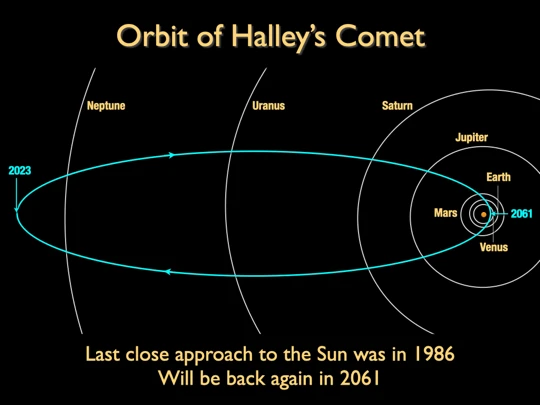
46
New cards
What is the difference between the nucleus and the coma of a comet?
* **Nucleus** = the core of rock and ice.
* **Coma** = extremely rarefied sphere of gas and dust surrounding the nucleus (\~100,000 km across) formed as the temperature rises as a comet approaches the Sun.
* **Coma** = extremely rarefied sphere of gas and dust surrounding the nucleus (\~100,000 km across) formed as the temperature rises as a comet approaches the Sun.
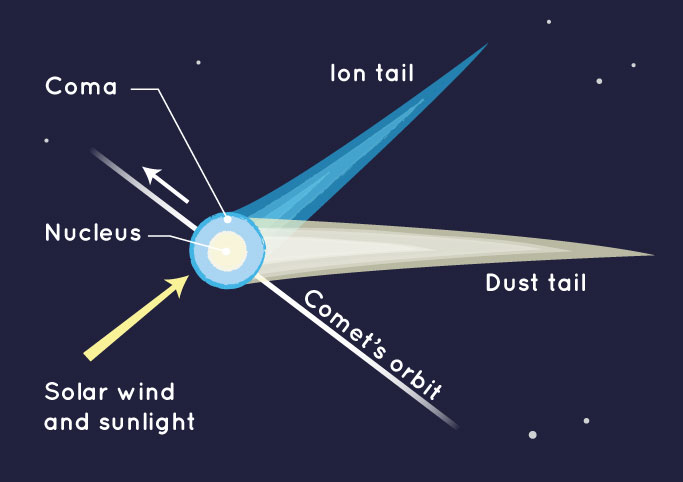
47
New cards
Explain the two types of tail on a comet?
1. **Gas Tail**: Blue-coloured, straight ion tail consisting of atoms and molecules of gas (mostly carbon monoxide) that have been ionised by the solar wind.
2. **Dust Tail**: Lighter-coloured, shorter, broader and slightly curved dust tail produced by radiation pressure that pushes particles out of the nucleus; this tail shines by reflecting sunlight and its curvature is due to the individual dust particles following their own independent solar orbit.

48
New cards
Define the terms: meteoroid, meteor, meteorite.
* **Meteoroid** = small rocky (with perhaps some iron-nickel content) irregular lumps of debris in the Solar System.
* **Meteor** = when meteoroids enter the Earth’s atmosphere, friction causes the meteoroid and surrounding air to heat up producing a short streak of incandescent light.
* **Meteorite** = if part of a meteoroid survives its passage through the atmosphere, it lands on the Earth’s surface and is called a meteorite.
* **Meteor** = when meteoroids enter the Earth’s atmosphere, friction causes the meteoroid and surrounding air to heat up producing a short streak of incandescent light.
* **Meteorite** = if part of a meteoroid survives its passage through the atmosphere, it lands on the Earth’s surface and is called a meteorite.
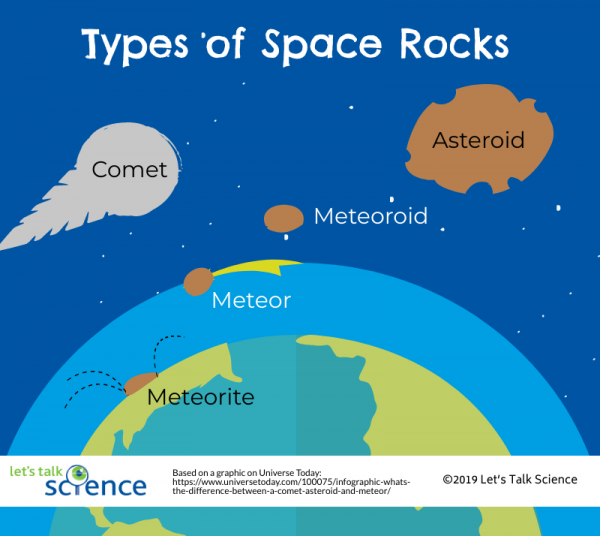
49
New cards
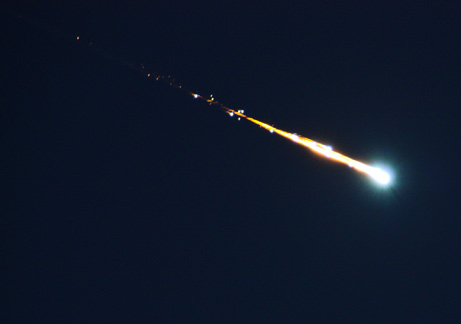
What is a fireball?
A meteor with a **magnitude of -3 or brighter**.
50
New cards
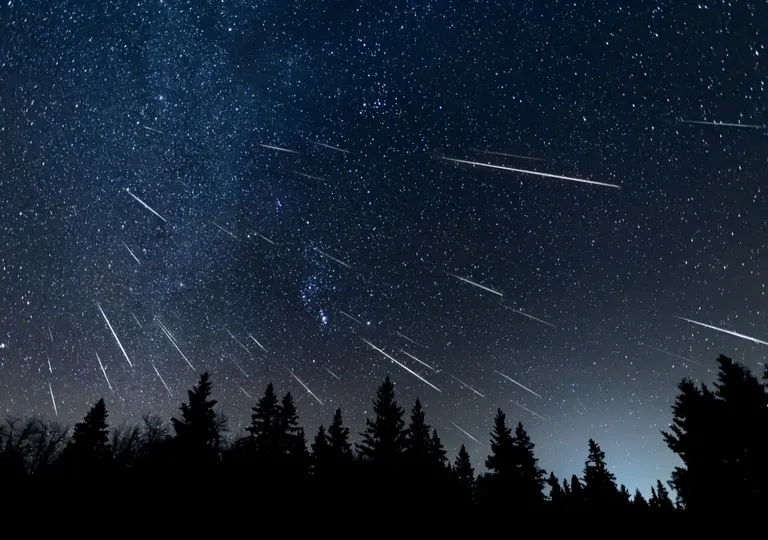
Name four annual meteor showers.
1. Perseids (August),
2. Quandrantids (January),
3. Leonids (November),
4. Geminids (December).
51
New cards
What is a radiant?
The **point in the sky from which meteors of any particular shower appear to radiate**.
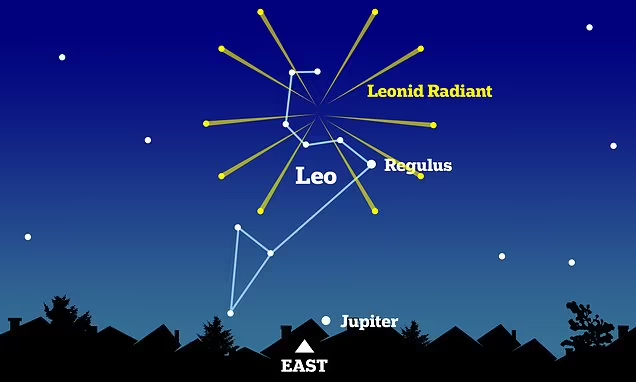
52
New cards
What is a Near Earth Object (NEO)?
Any asteroid or comet with an orbit that brings them close to the Earth (**closer than 0.3 AU**)
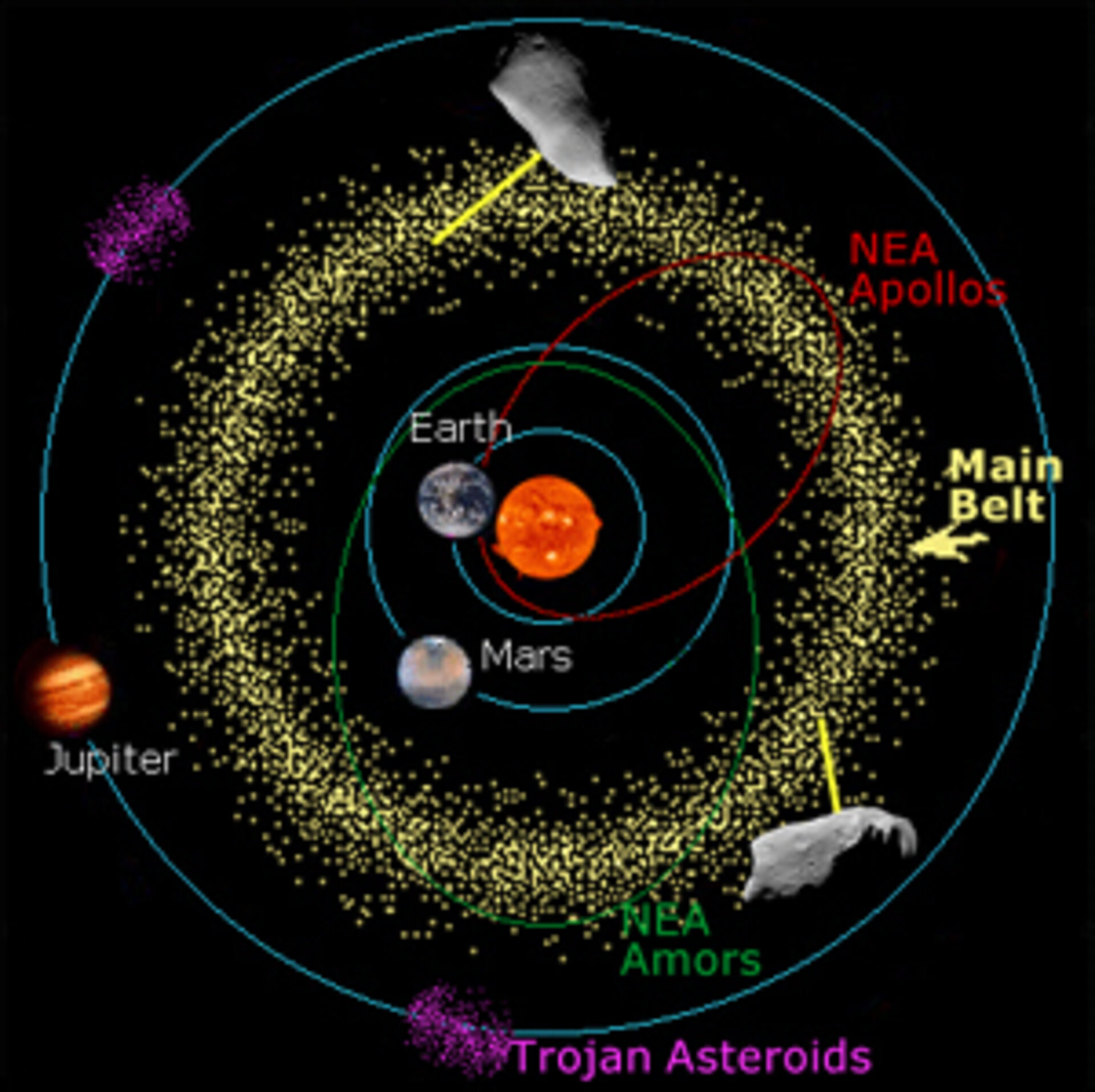
53
New cards
What is a Potentially Hazardous Object (PHO)?
An NEO whose orbit brings it within **0.05 AU** of Earth
54
New cards
What evidence is there for collisions between astronomical bodies?
* Craters on the Moon,
* asteroids and other planets;
* the unusual rotations of Venus and Uranus;
* evidence for the Giant Impact Hypothesis;
* direct observation of the collision between Jupiter and Shoemaker-Levy in 1994;
* evidence of PHO impact craters on Earth (Barringer, Chicxulub, Tunguska).
* asteroids and other planets;
* the unusual rotations of Venus and Uranus;
* evidence for the Giant Impact Hypothesis;
* direct observation of the collision between Jupiter and Shoemaker-Levy in 1994;
* evidence of PHO impact craters on Earth (Barringer, Chicxulub, Tunguska).
55
New cards
What scale is used to categorise impact hazards and potential risks?
The Torino scale.
56
New cards
What are the names of the two models of the Solar System?
Geocentric and heliocentric.
57
New cards
What was Copernicus’ contribution to the geocentric vs. heliocentric argument?
* Proposed a heliocentric model to explain the occasional retrograde motion of Mars, Jupiter and Saturn.
58
New cards
What was Tycho’s contribution to the geocentric vs. heliocentric argument?
Undertook meticulous observations of the skies with meticulous precision.
59
New cards
What is Kepler’s first law of planetary motion?
**Planets move in elliptical orbit around the Sun**, with the Sun at one focus of each ellipse.
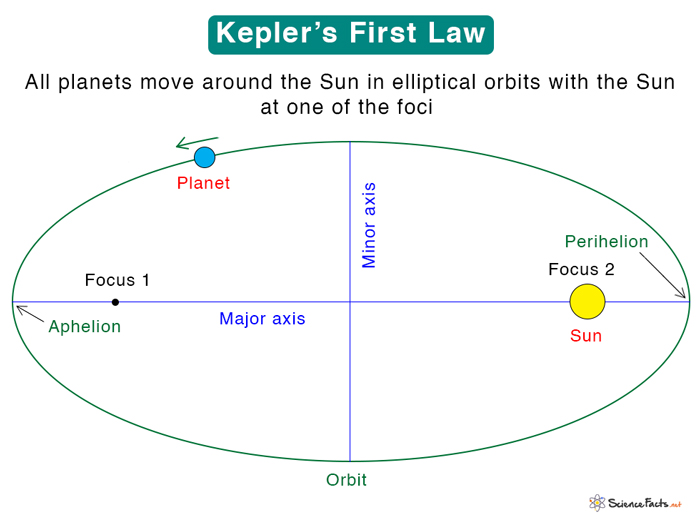
60
New cards
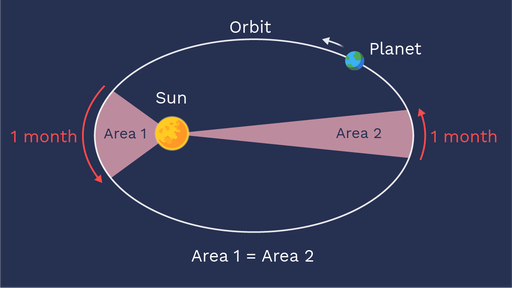
What is Kepler’s second law of planetary motion?
An **imaginary line from a planet to the Sun sweeps out equal areas in equal intervals of time**.
61
New cards
Mathematically, what is Kepler’s third law of planetary motion?
\
**T^2 = r^3**
\
where:
**T** is the orbital period of a planet in years
**r** is its mean distance from the Sun in AU.
**T^2 = r^3**
\
where:
**T** is the orbital period of a planet in years
**r** is its mean distance from the Sun in AU.
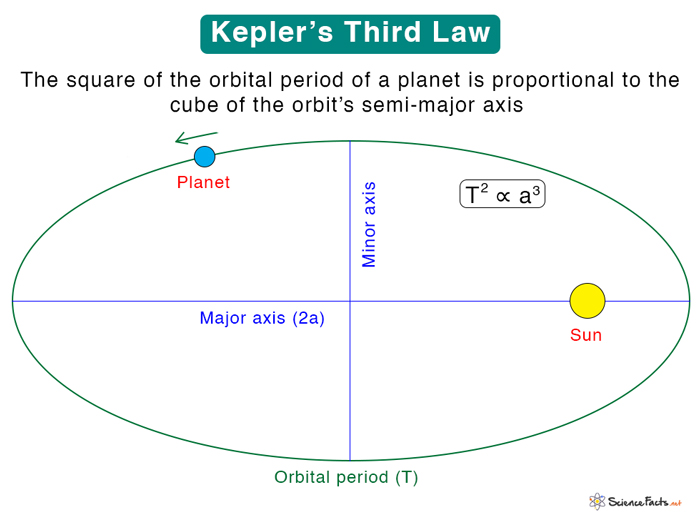
62
New cards
What were Galileo’s three major astronomical discoveries relating to the Solar System?
1. Phases and apparent size of Venus;
2. relief features of the Moon;
3. principal satellites of Jupiter (Ganymede, Io, Callisto, Europa).
63
New cards
Who discovered Uranus and how?
**William** **Herschel** in 1781. He first mistook it for a comet, but subsequent observations allowed him to determine an orbit from which he deduced the object to be a planet.
64
New cards
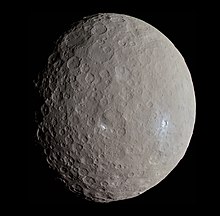
Who discovered Ceres and how?
**Giuseppe Piazzi** in 1801. Several astronomers had predicted that an undiscovered planet lay in the obvious gap between the orbits of Mars and Jupiter. He noted a faint ‘star’ had moved in position on several successive nights.
65
New cards
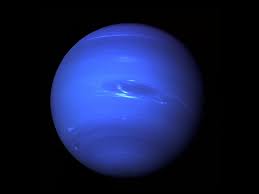
Who discovered Neptune and how?
**Johann Galle** in 1846. Discovered first night of telescopic observation based on the predictions of the existence of Neptune to explain observed irregularities in the motion of Uranus.
66
New cards

Who discovered Pluto and how?
Clyde Tombaugh in 1930. Located by photographic techniques.
67
New cards
What is gravitation?
The force of attraction that exists between all particles of matter in the Universe.
68
New cards
Mathematically, what is Newton’s law of gravitation?
\
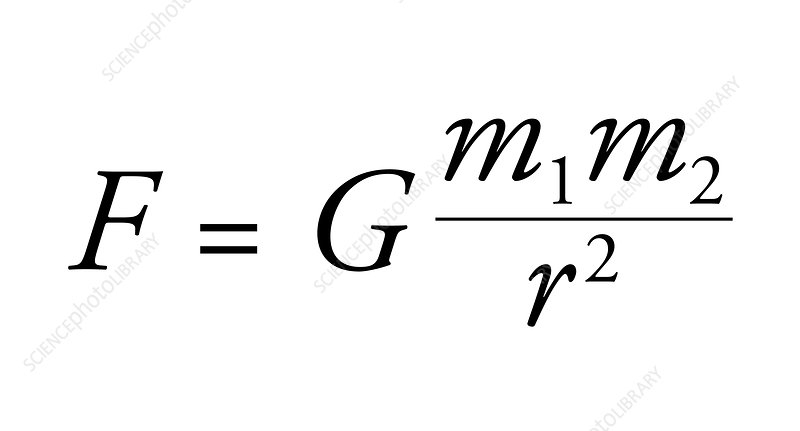
69
New cards
What is meant by an inverse square law?
As the distance between two objects doubles, the force between them is one quarter of its previous value.
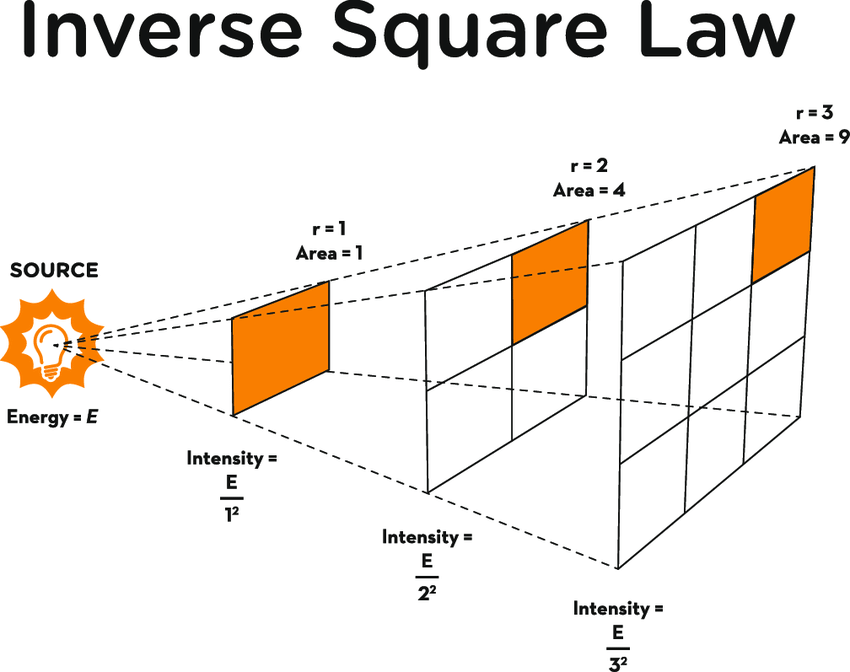
70
New cards
What are the three main techniques for detecting or inferring the presence of exoplanets?
1. Astrometry,
2. transit method,
3. radial-velocity method (using Doppler shifts).
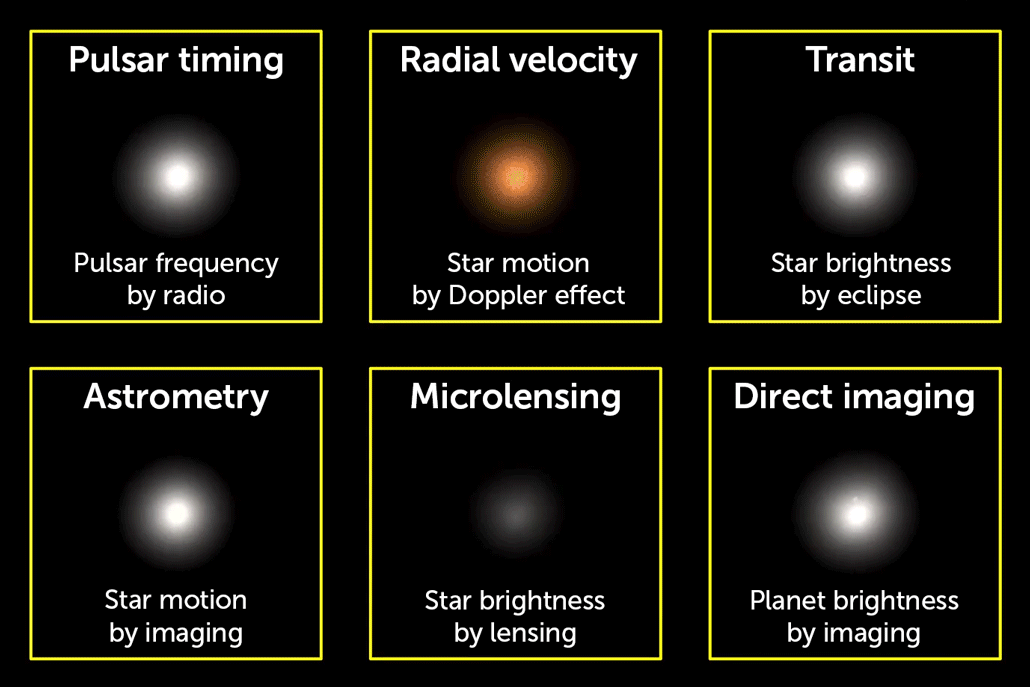
71
New cards
What are the difficulties with detecting individual planets?
Current methods do not allow the discovery of small, rocky exoplanets similar to Earth because atmospheric turbulence and the fact that **planets with a relatively small mass have less significant effect on their host star**.
72
New cards
What do scientists think are the two essential chemical ingredients for life?
1. Carbon
2. liquid water
73
New cards
What are the two principal theories for the origin of water on Earth?
1. Outgassing of hydrogen and oxygen from volcanoes that combined to produce steam that condensed into water;
2. deposited by comets (containing ice) striking Earth
74
New cards
What methods have astronomers used to determine the origin of water on Earth?
* space probe placed a lander on comet
* scientific instruments then analysed the comet’s water content and examine whether it has the same relative abundances of isotopes as water on Earth.
* scientific instruments then analysed the comet’s water content and examine whether it has the same relative abundances of isotopes as water on Earth.
75
New cards
What factors are included in the Drake equation for assessing the likelihood of life existing elsewhere in our galaxy?
* Number of stars in our galaxy;
* fraction of stars with planetary systems;
* number of planets capable of sustaining life;
* fraction of life-forms that are intelligent;
* fraction of these that can and wish to communicate;
* fraction of a planet’s lifetime for which such civilisations can live
* fraction of stars with planetary systems;
* number of planets capable of sustaining life;
* fraction of life-forms that are intelligent;
* fraction of these that can and wish to communicate;
* fraction of a planet’s lifetime for which such civilisations can live
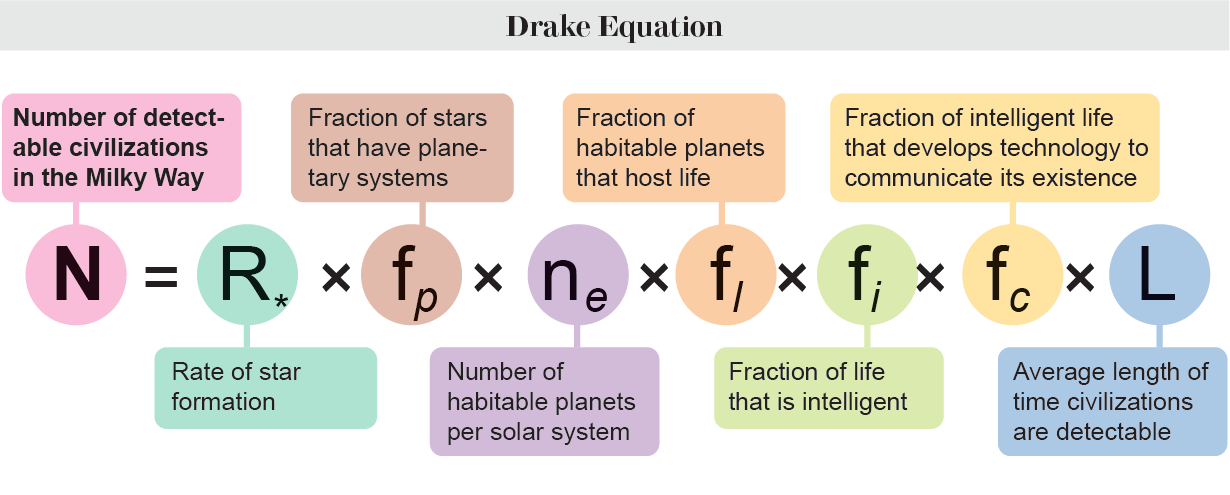
76
New cards
What is meant by the term “habitable zone”?
**A narrow range of distances from the star in which the temperature allows liquid water to exist** (sometimes called the Goldilocks Zone because it is “neither too hot nor too cold”)
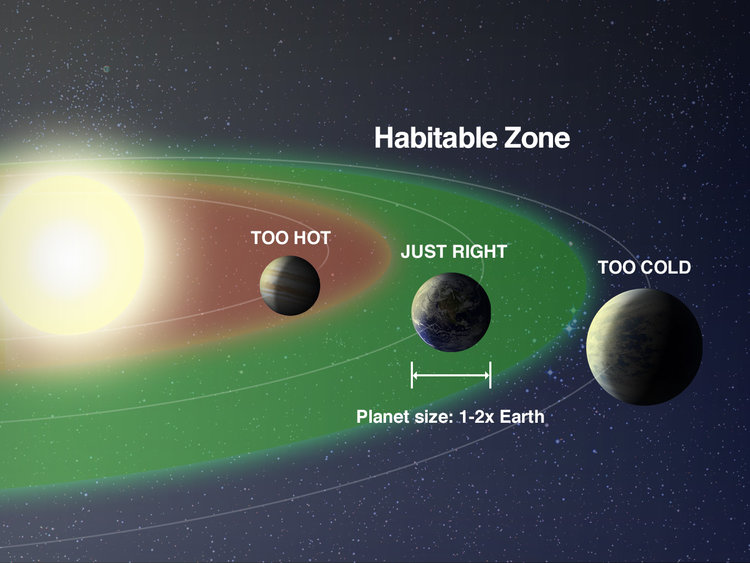
77
New cards
Name two other bodies in our Solar System that are candidates for micro-organisms to exist.
1. Mars,
2. Jupiter’s moon Europa.
78
New cards
State some methods astronomers use to search for signs of life on other planets?
* Space probes,
* spectral analysis of planetary atmospheres above rocky exoplanets to **search for gases such as oxygen and methane that are produced by living organisms**;
* analysis of **radio waves** from space to try to **detect signals that have originated from ET intelligent forms** of life in our galaxy
* spectral analysis of planetary atmospheres above rocky exoplanets to **search for gases such as oxygen and methane that are produced by living organisms**;
* analysis of **radio waves** from space to try to **detect signals that have originated from ET intelligent forms** of life in our galaxy
79
New cards
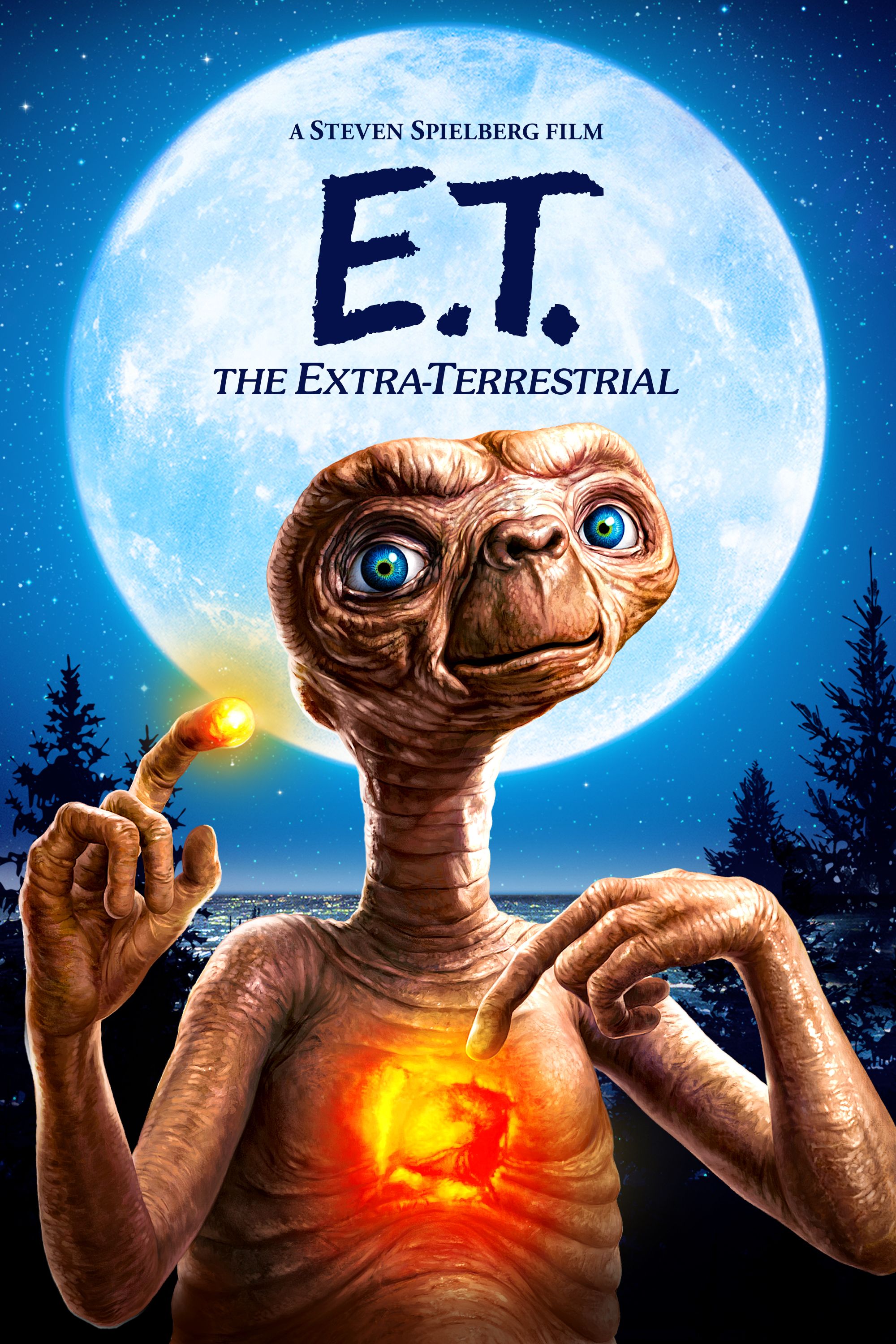
What are the possible disadvantages of discovering ET life?
* Would it be wise to transfer organisms from one environment into a totally different one in which they might become extinct or adapt too well and flourish?
* We know nothing of the intent or capabilities of possible alien life-forms – could continued life on Earth be threatened?
* Do we really want to discover that we are not alone in the Universe?
* We know nothing of the intent or capabilities of possible alien life-forms – could continued life on Earth be threatened?
* Do we really want to discover that we are not alone in the Universe?